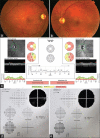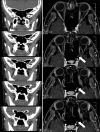Bilateral Visual Loss Caused by Pneumosinus Dilatans: Idiopathic Cases are not Always Reversible
- PMID: 34409232
- PMCID: PMC8365582
- DOI: 10.4103/2452-2325.288940
Bilateral Visual Loss Caused by Pneumosinus Dilatans: Idiopathic Cases are not Always Reversible
Abstract
Purpose: To report a rare case of primary pneumosinus dilatans (PSD) and to specify the cardinal imaging findings associated with this condition.
Methods: A 20-year-old patient presented with bilateral profound visual loss as a result of primary PSD. A detailed review of clinical findings and presumed pathophysiological basis of vision loss was performed.
Results: Other than undiagnosed primary hypothyroidism, no other abnormalities were found. With the diagnosis of PSD, the patient underwent optic nerve decompression through transnasal sphenoidotomy. However, after nine months of follow-up, no improvement in the patient's vision was attained.
Conclusion: Unlike previous reports of favorable visual results after sphenoidotomy and bilateral decompression of the optic nerves, vision recovery was not achieved in this case.
Keywords: Optic atrophy; Paranasal sinus; Pneumosinus dilatans.
Copyright: © 2021 Journal of Current Ophthalmology.
Conflict of interest statement
There are no conflicts of interest.
Figures



Similar articles
-
Sphenoidal pneumosinus dilatans associated compressive optic neuropathy: A case series of four adolescent patients.Heliyon. 2024 Oct 5;10(20):e38763. doi: 10.1016/j.heliyon.2024.e38763. eCollection 2024 Oct 30. Heliyon. 2024. PMID: 39640786 Free PMC article.
-
Pneumosinus dilatans of the spheno-ethmoidal complex associated with hypovitaminosis D causing bilateral optic canal stenosis.Childs Nerv Syst. 2017 Jun;33(6):1005-1008. doi: 10.1007/s00381-017-3373-6. Epub 2017 Mar 13. Childs Nerv Syst. 2017. PMID: 28289839
-
Pneumosinus Dilatans: A Myriad of Symptomology.Indian J Otolaryngol Head Neck Surg. 2022 Oct;74(Suppl 2):1305-1309. doi: 10.1007/s12070-021-02418-x. Epub 2021 Feb 4. Indian J Otolaryngol Head Neck Surg. 2022. PMID: 36452632 Free PMC article.
-
Maxillary Pneumosinus Dilatans Presenting With Proptosis: A Case Report and Review of the Literature.Clin Med Insights Ear Nose Throat. 2019 Feb 3;12:1179550618825149. doi: 10.1177/1179550618825149. eCollection 2019. Clin Med Insights Ear Nose Throat. 2019. PMID: 30774495 Free PMC article. Review.
-
[Pneumosinus dilatans--general considerations and a case report].Oftalmologia. 2011;55(2):87-91. Oftalmologia. 2011. PMID: 21888075 Review. Romanian.
Cited by
-
Bilateral Vision Loss in an Adult Patient with Woakes' Syndrome: An Unprecedented Case.J Curr Ophthalmol. 2022 Jul 26;34(2):264-266. doi: 10.4103/joco.joco_302_21. eCollection 2022 Apr-Jun. J Curr Ophthalmol. 2022. PMID: 36147257 Free PMC article.
-
Beyond aesthetics: A case report of pneumosinus dilatans frontalis presenting with headache.Int J Surg Case Rep. 2024 Feb;115:109272. doi: 10.1016/j.ijscr.2024.109272. Epub 2024 Jan 13. Int J Surg Case Rep. 2024. PMID: 38219520 Free PMC article.
-
Sphenoidal pneumosinus dilatans associated compressive optic neuropathy: A case series of four adolescent patients.Heliyon. 2024 Oct 5;10(20):e38763. doi: 10.1016/j.heliyon.2024.e38763. eCollection 2024 Oct 30. Heliyon. 2024. PMID: 39640786 Free PMC article.
References
-
- Ricci JA. Pneumosinus dilatans: Over 100 years without an etiology. J Oral Maxillofac Surg. 2017;75:1519–26. - PubMed
-
- Desai NS, Saboo SS, Khandelwal A, Ricci JA. Pneumosinus dilatans: Is it more than an aesthetic concern? J Craniofac Surg. 2014;25:418–21. - PubMed
-
- Andrew T, Voglewede JM. Bilateral pneumosinus dilatans of the sphenoid sinuses causing visual loss. Int J Pediatr Otorhinolaryngol Extra. 2015;10:79–83.
-
- Parizel PM, Carpentier K, Van Marck V, Venstermans C, De Belder F, Van Goethem J, et al. Pneumosinus dilatans in anterior skull base meningiomas. Neuroradiology. 2013;55:307–11. - PubMed
Publication types
LinkOut - more resources
Full Text Sources
